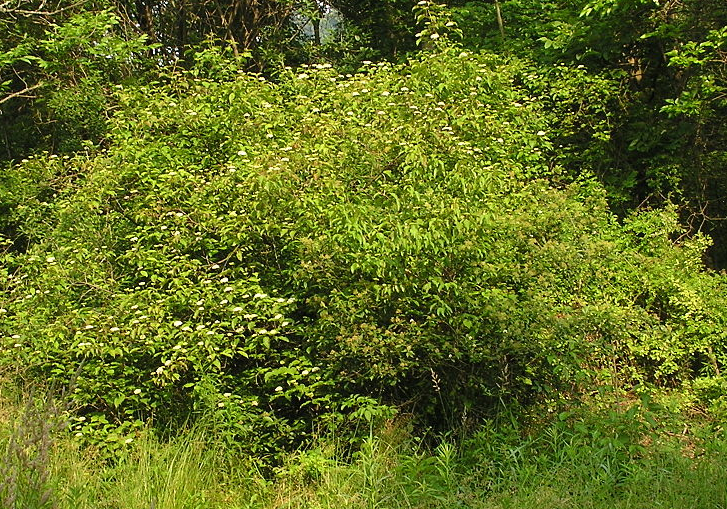
Also known as pale dogwood, swamp dogwood, red willow, silky cornel, kinnikinnick, and squawbush this deciduous shrub is native to parts of Canada and eastern and central US, from Vermont and Michigan south to Florida and Alabama where it grows near streams and ponds and in wetlands, floodplains, and swamp borders. It is a member of the dogwood family, Cornaceae, a small family of only to genera with 85 species. The shrub grows 6-12′ tall and has an open rounded form. New growth may be greenish-purple to dark reddish-purple and densely covered with fine hairs but becomes dark purple with maturity. The oval to elliptic leaves are 2-5″ long, and have conspicuous veins and hairy undersides. They are medium to dark green during the growing season but turn may turn brown, or purplish-red in the fall. Creamy-white flowers appear in flat topped clusters 1-2.5″ across from late spring to early summer. The flowers are about 3/8″ across, have four petals, four sepals, and four long stamens, and attract butterflies and bees. The round berry-like fruits that follow in clusters are 1/4″ across, change from white to blue as they ripen, and are eaten by birds and small mammals from late summer into fall. Silky dogwood is a good choice for erosion control and use in naturalized areas, along waterways and around ponds, as well as in native plant, wildlife, pollinator, butterfly, shade, rain and woodland gardens. The genus name, Cornus, is the Latin word meaning horn and may refer to the hardness and strength of the wood of some species. The specific epithet, amomum, is the Latin word referring to an aromatic plant. Photo Credit: SB Johnny, Wikipedia

Type: Flowering deciduous shrub
Outstanding Features: Tolerance of occasionally wet soil; wildlife food and protection
Form: Rounded
Growth Rate: Medium
Bloom: Clusters of small white flowers from late spring into early summer
Size: 6-12′ H x 6-12″ W
Light: Sun to partial shade; tolerates heavy shade
Soil: Average, moist to occasionally wet, well-drained, acidic
Hardiness: Zones 5-8
Care: Mulch roots in summer to keep them moist and cool; remove suckers to control spread
Pests and Diseases: Susceptible to scale, borers, leaf miners, leaf spot, crown canker, blights, root rot, and powdery mildew.
Propagation: Seed, hardwood cuttings, layering
Outstanding Selections:
‘Indigo’
Photo Credit: SB Johnny, Wikipedia